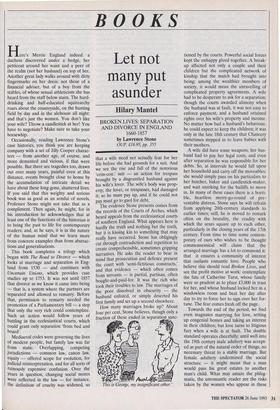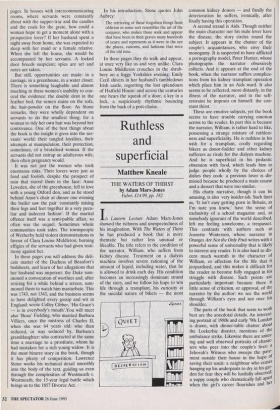BOOKS
Let not many put asunder
Hilary Mantel
BROKEN LIVES: SEPARATION AND DIVORCE IN ENGLAND 1660-1857 by Lawrence Stone OUP, £16.95, pp. 355 Here's Merrie England indeed: a duchess discovered under a hedge, her petticoat around her waist and a peer of the realm (not her husband) on top of her. Another great lady walks around with dirty fingermarks on her dress: not those of a financial adviser, but of a boy from the stables, of whose sexual athleticism she has heard from the staff below stairs. The hard- drinking and half-educated squirearchy roars about the countryside, on the hunting field by day and in the alehouse all night: and that's just the women. You don't like your wife? Throw a candlestick at her! You have to negotiate? Make sure to take your horsewhip.
Occasionally, reading Lawrence Stone's case histories, you think you are keeping company with a set of Jilly Cooper charac- ters — from another age, of course, and more demented and vicious, if that were possible. But there are tragedies too, drawn out over many years, painful even at this distance, events brought close to home by the accumulation of intricate detail we have about these long-gone, shattered lives. If you said that this weighty and serious book was as good as an armful of novels, Professor Stone might not take that as a compliment. Then again, he might, for in his introduction he acknowledges that at least one of the functions of the historian is to bring the past to life for contemporary readers; and, as he says, it is in the nature of the human mintl that we learn more from concrete examples than from abstrac- tions and generalisations.
This book completes a trilogy which began with The Road to Divorce — which looks at marriage and separation in Eng- land from 1530 — and continues with Uncertain Unions, which provides case studies up to 1753. It was not until 1857 that divorce as we know it came into being — that is, a system where the partners are separated and allowed to remarry. Before that, permission to remarry needed the promotion of a Parliamentary bill — a step that only the very rich could contemplate. Such an action would follow years of battling in the ecclesiastical courts, which could grant only separation 'from bed and board'.
Mediaeval codes were governing the lives of modern people, but family law was far from static. Overlapping, competing Jurisdictions — common law, canon law, equity — offered scope for evolution, for Judicial reinterpretation, and for all sorts of ruinously expensive confusion. Over the Years in question, changing social mores were reflected in the law — for instance, the definition of cruelty was widened, so that a wife need not actually fear for her life before she had grounds for a suit. And we see the rise and fall of the notorious `crim-con.' suit — an action for trespass brought by a disgruntled husband against his wife's lover. The wife's body was prop- erty; the lover, or trespasser, had damaged it; so he must pay up, and if he could not pay must go to gaol for debt. The evidence Stone presents comes from the records of the Courts of Arches, which heard appeals from the ecclesiastical courts of southern England. What appears here is hardly the truth and nothing but the truth, but it is kissing kin to something that may really have occurred. Stone has obligingly cut through contradiction and repetition to create comprehensible, sometimes gripping narratives. He asks the reader to bear in mind that prosecution and defence present the court with 'semi-fictitious constructs,' and that evidence — which often comes from servants — is partial, partisan, often bought-and-paid-for. It was the rich who took their troubles to law. The marriages of the poor dissolved in obscurity — the husband enlisted, or simply deserted his first family and set up a second elsewhere.
How many marriages broke up? About four per cent, Stone believes, though only a fraction of these ended in separation sane-
This is George, my insignificant other.'
tioned by the courts. Powerful social forces kept the unhappy glued together, A break- up affected not only a couple and their children but the complicated network of kinship that the match had brought into being; among the wealthier members of society, it would mean the unravelling of complicated property agreements. A wife had to be desperate to ask for a separation; though the courts awarded alimony when the husband was at fault, it was not easy to enforce payment, and a husband retained rights over his wife's property and income. No matter how bad a husband's behaviour, he could expect to keep the children; it was only in the late 18th century that Chancery sometimes stepped in to leave babies with their mothers.
A wife did have some weapons; her hus- band had to pay her legal costs, and even after separation he was responsible for her debts. So, at intervals he would fall upon her household and carry off the moveables; she would simply pass on his particulars to her butcher, baker and candlestick-maker, and wait smirking for the bailiffs to move in. In many of these cases there is a horri- ble, heartless merry-go-round of pre- ventable distress. Stone says he will refrain from applying 20th-century standards to earlier times; still, he is moved to remark often on the brutality, the crudity with which the sexes square up to each other, particularly in the closing years of the 17th century. From time to time some contem- porary of ours who wishes to be thought commonsensical will claim that the arranged marriage has a lot to commend it: that it ensures a community of interest that outlasts romantic love. People who believe this should read Broken Lives, and see the profit motive at work: contemplate the fate of Catherine Turst, whose family were so prudent as to place £3,000 in trust for her, and whose husband locked her in a windowless room and beat her day after day to try to force her to sign over her for- tune. The fear comes fresh off the page.
Towards the end of the period, we find even magnates marrying for love, setting up congenial homes and taking an interest in their children; but love turns to litigious fury when a wife is at fault. The double standard operates cheerfully; until well into the 19th century male adultery was accept- ed as part of the natural order of things, no necessary threat to a stable marriage. But female adultery undermined the social structure — it might mean that a man would pass his great estates to another man's child. What may amaze the phleg- matic, the unromantic reader are the risks taken by the women who appear in these pages. In houses with intercommunicating rooms, where servants were constantly about with the supper-tray and the candles and the coals for the grate, how could a woman hope to get a moment alone with a prospective lover? If her husband spent a night away from home, she was expected to sleep with her maid or a female relative. When she left the house, she would be accompanied by her servants. A locked door breeds suspicion; spies are set and notes are taken.
But still, opportunities are made: in a carriage, in a greenhouse, in a water closet. There is something laughable and almost touching in these women's inability to con- ceal the evidence: the double dent in the feather bed, the semen stains on the sofa, the hair-powder on the floor. As Stone remarks, they were wholly dependent on servants to do the smallest thing; for a woman to tidy her own hair was beyond her contrivance. One of the best things about the book is the insight it gives into the ser- vants' world: their tangled loyalties, their attempts at manipulation, their protection, sometimes, of a brutalised woman. If the servants did not entrap an adulterous wife, then often pregnancy would.
It was not just the women who took enormous risks. Their lovers were just as fond and foolish, despite the prospect of ruin that stared them in the face: Anne Loveden, she of the greenhouse, fell in love with a young Oxford don, and as he stood behind Anne's chair at dinner one evening the butler saw the pair 'constantly mixing their legs and feet together in a very pecu- liar and indecent fashion'. If the marital offence itself was a semi-public affair, so often was the sequel. Sometimes whole communities took sides. The townspeople of Wetherby held violent demonstrations in favour of Clara Louise Middleton, burning effigies of the servants who had given testi- mony against her.
In these pages you will address the deli- cate matter of the Duchess of Beaufort's bedsheets, and learn of her allegations that her husband was impotent: the Duke sum- moned a convocation of worthies and, after retiring for a while behind a screen, sum- moned them to watch him masturbate. This was 1743, not 1343, and the business seems to have delighted every gossip and wit in England: wrote Colley Cibber, 'His Grace's — is in everybody's mouth'.You will meet also 'Beau' Fielding, who married Barbara Villiers, once the mistress of Charles II, when she was 64 years old: who then seduced, or was seduced by, Barbara's granddaughter: who contracted at the same time a marriage to a prostitute, whom he had mistaken for a rich young widow. It is the most bizarre story in the book, though it has plenty of competition. Lawrence Stone works his technical detail smoothly into the body of the text, guiding us even through the complexities of Westmeath v. Westmeath, the 15-year legal battle which brings us to the 1857 Divorce Act.
In his introduction, Stone quotes John Aubrey:
The retrieving of these forgotten things from oblivion in some sort resembles the art of the conjuror, who makes those walk and appear that have been in their graves many hundreds of years; and represents as it were to the eye the places, customs, and fashions that were of the old time.
In these pages they do walk and appear, at once very like us and very unlike. Clara Louise Middleton crouches in the shrub- bery on a foggy Yorkshire evening: Emily Cecil shivers in her husband's tumbledown Irish castle, regretting the lost splendours of Hatfield House: and across the centuries one hears the squeak of a door, a key in a lock, a suspiciously rhythmic bouncing from the back of a post-chaise.



























































 Previous page
Previous page